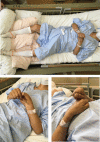Response to benzodiazepines and the clinical course in malignant catatonia associated with schizophrenia: A case report
- PMID: 28422845
- PMCID: PMC5406061
- DOI: 10.1097/MD.0000000000006566
Response to benzodiazepines and the clinical course in malignant catatonia associated with schizophrenia: A case report
Abstract
Background: Malignant catatonia (MC) is a disorder consisting of catatonic symptoms, hyperthermia, autonomic instability, and altered mental status. Neuroleptic malignant syndrome (NMS) caused by antipsychotics is considered a variant of MC. Benzodiazepine (BZD) medications are safe and effective treatments providing rapid relief from MC. This case study reports a detailed clinical course of a case of MC associated with schizophrenia initially diagnosed as NMS that responded successfully to BZDs but not to dantrolene.
Case presentation: A 53-year-old man with schizophrenia was admitted to the psychiatric hospital because of excitement, monologue, muscle rigidity, and insomnia. In the 3 days before admission, the patient had discontinued his medications after his family member's death. He presented with hyperthermia, tachycardia, hypertension, excessive sweating, and an elevated serum creatine phosphokinase (CPK) level. On the basis of these features, he was suspected to have NMS. The patient was treated with dantrolene for 7 days without improvement despite having a normalized serum CPK level. The patient was transferred to our university hospital for an in-depth examination and treatment of his physical status. Infection and pulmonary embolism were excluded as possible causes. To treat his excitement and auditory hallucination, an intravenous drip (IVD) of haloperidol was initiated, but this treatment increased the patient's catatonic and psychotic symptoms, although his serum CPK level had remained within a normal range. As a result, the treatment was changed to diazepam. After an IVD of diazepam, the patient's symptoms rapidly improved, and the IVD was subsequently replaced with oral administration of lorazepam. Eventually, the patient was diagnosed with MC associated with schizophrenia. BZD therapy was dramatically effective.
Conclusion: Catatonia, MNS, and MC may be due to a common brain pathophysiology and these conditions may be in a spectrum, although uncertainty in the boundaries among conditions, and the BZD treatment may be useful. Most importantly, catatonia has not been described as a subtype of schizophrenia on the basis of the Diagnostic and Statistical Manual of Mental Disorders (DSM)-5 criteria, and the medications for catatonia and schizophrenia are different. Antipsychotics are not effective in relieving catatonia, or they may induce NMS, whereas BZDs are effective for treating both MC and NMS.
Figures


Similar articles
-
[Diazepam-responsive malignant catatonia in a patient with an initial clinical diagnosis of neuroleptic malignant syndrome: a case report].Brain Nerve. 2011 May;63(5):503-7. Brain Nerve. 2011. PMID: 21515931 Japanese.
-
[Catatonia in a 14 year-old girl: treatment with clorazepam and carbamazepine, a 10-year follow-up].Encephale. 2010 Feb;36(1):46-53. doi: 10.1016/j.encep.2009.01.006. Epub 2009 May 12. Encephale. 2010. PMID: 20159196 French.
-
Catatonic variants, hyperthermic extrapyramidal reactions, and subtypes of neuroleptic malignant syndrome.Ann Clin Psychiatry. 2007 Jan-Mar;19(1):9-16. doi: 10.1080/10401230601163477. Ann Clin Psychiatry. 2007. PMID: 17453656
-
Neuroleptic Malignant Syndrome/Malignant Catatonia in Child Psychiatry: Literature Review and a Case Series.J Child Adolesc Psychopharmacol. 2017 May;27(4):359-365. doi: 10.1089/cap.2016.0180. Epub 2017 Feb 23. J Child Adolesc Psychopharmacol. 2017. PMID: 28398818 Review.
-
[Catatonia: resurgence of a concept. A review of the international literature].Encephale. 2002 Nov-Dec;28(6 Pt 1):481-92. Encephale. 2002. PMID: 12506260 Review. French.
Cited by
-
Meta-analysis of physical activity and effects of social function and quality of life on the physical activity in patients with schizophrenia.Eur Arch Psychiatry Clin Neurosci. 2019 Aug;269(5):517-527. doi: 10.1007/s00406-018-0903-5. Epub 2018 May 22. Eur Arch Psychiatry Clin Neurosci. 2019. PMID: 29789938
-
Catatonia: Clinical Overview of the Diagnosis, Treatment, and Clinical Challenges.Neurol Int. 2021 Nov 8;13(4):570-586. doi: 10.3390/neurolint13040057. Neurol Int. 2021. PMID: 34842777 Free PMC article. Review.
-
Pharmacologic Treatment of Malignant Catatonia Without Electroconvulsive Therapy: A Case Report.Cureus. 2024 Apr 11;16(4):e58071. doi: 10.7759/cureus.58071. eCollection 2024 Apr. Cureus. 2024. PMID: 38737995 Free PMC article.
-
Successful diagnosis and treatment of pulmonary aspergillosis-related malignant catatonia using propofol and quetiapine: A case report.Medicine (Baltimore). 2021 May 14;100(19):e25967. doi: 10.1097/MD.0000000000025967. Medicine (Baltimore). 2021. PMID: 34106671 Free PMC article.
-
Malignant Catatonia Mimics Tetanus.Clin Pract Cases Emerg Med. 2018 Aug 15;2(4):369-370. doi: 10.5811/cpcem.2018.7.38585. eCollection 2018 Nov. Clin Pract Cases Emerg Med. 2018. PMID: 30443633 Free PMC article. No abstract available.
References
-
- Taylor MA, Fink M. Catatonia in psychiatric classification: a home of its own. Am J Psychiatry 2003;160:1233–41. - PubMed
-
- Lotstra F, Linkowski P, Mendlewicz J. General anesthesia after neuroleptic malignant syndrome. Biol Psychiatry 1983;18:243–7. - PubMed
-
- Mann SC, Caroff SN, Bleier HR, et al. Lethal catatonia. Am J Psychiatry 1986;143:1374–81. - PubMed
-
- Philbrick KL, Rummans TA. Malignant catatonia. J Neuropsychiatry Clin Neurosci 1994;6:1–3. - PubMed
Publication types
MeSH terms
Substances
LinkOut - more resources
Full Text Sources
Other Literature Sources
Medical
Research Materials

